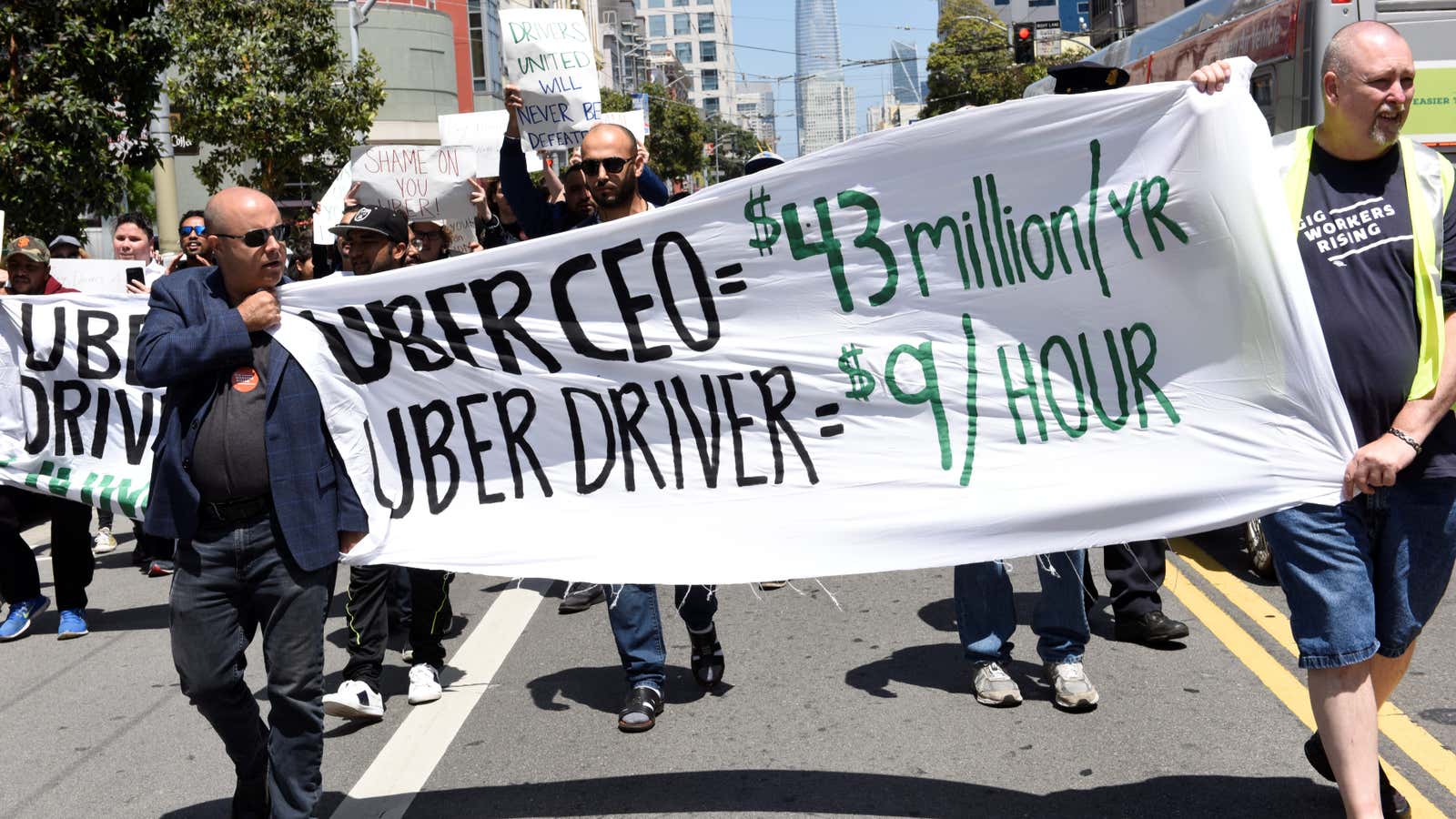Uber has always been disruptive, to steal a phrase from Silicon Valley, so it’s fitting that the days ahead of its much-anticipated IPO have been disrupted by a global driver strike.
Drivers gathered on May 8 to protest Uber and its labor practices in cities from Los Angeles to Atlanta to New York in the US, and in countries from Brazil to Australia to the UK abroad. The strikes, which also targeted Lyft, to a lesser degree, garnered support from Democratic presidential candidates Bernie Sanders, Joe Biden, and Pete Buttigieg, among others, as well as Catastrophe co-star Rob Delaney. They also received extensive coverage online and on cable news.
How the demonstrations went, though, was less clear. The New York Post, for instance, reported yesterday that the strike in New York City was a “flop,” with cars plentiful and surge pricing scarce (the actual strike was scheduled for only two hours, from 7am to 9am local time). In San Francisco, a small crowd of drivers gathered outside Uber headquarters to demand better benefits and higher wages. “There are fewer people here than I think they anticipated,” the local CBS anchor admitted in a broadcast.
Uber didn’t respond to a request for comment. Lyft spokeswoman Chelsea Harrison said in an emailed statement: “Lyft drivers’ hourly earnings have increased 7% over the last two years… We’re constantly working to improve how we can best serve our driver community.”
Collective action has largely eluded drivers over Uber’s 10-year history. The company considers its drivers to be independent contractors, and in the US there are no collective bargaining rights afforded to contractors. Early attempts at strikes by driver groups were easily broken up by the company, which could pull one of its many levers—surge pricing, promotions, and so on—to ensure a critical mass of drivers stayed on the road. Uber has aggressively fought a first-of-its-kind 2015 law in Seattle that gave local drivers permission to unionize. It preempted a similar effort in New York City by sanctioning the Independent Drivers Guild (paywall), a non-union driver advocacy group that helped organize the May 8 strike.
I took an Uber on the day of the strike, which I suppose makes me a bad person, but I was in suburban Connecticut and needed a ride to the train station, and had no other options. My driver had briefly heard about the strike from a family member who saw it on TV, but didn’t know any details of where or when it was happening, or what was expected of him. We chatted about what it’s like driving for Uber and Lyft and how rising gas prices have depressed his wages. He said he hoped once Uber went public, it would finally give drivers the recognition they deserve.
While an IPO seems unlikely to make Uber change its ways, it’s also hard to see what a strike accomplishes. The public pressure may last a few days, but sooner or later people need to make money and get places, and Uber for all its faults helps them do that. The plight of contractors in the gig economy has also been a talking point for nearly a decade, and it will take more than some tweets from Democratic favorites to get anything substantial passed to improve their lot. The most successful efforts to help drivers have come from sustained local pressure, like the multi-year Independent Drivers Guild campaign in New York that led the city to implement the first-ever pay floor for drivers in February.
More to the point, Uber emerged not unscathed but intact from 2017, a year that revealed a culture of sexual harassment and irresponsible management and led to the ouster of Uber’s co-founder and former CEO, next to which yesterday’s strike looks like a comparative blip. Uber also counted 3.9 million drivers on its platform as of Dec. 31, 2018. Tens, even hundreds, of thousands of those drivers could go on strike before the impact was really felt.
Drivers are understandably angry that Uber employees are about to get rich while they get additional pennies per trip, yet the company is still hemorrhaging money, and it’s unclear whether Uber could pay drivers more even if it wanted to. After New York City’s driver pay rules took effect, the company paused new driver signups and said in an amended IPO filing that the rules “had a negative impact on our financial performance” in the first quarter. Uber has also basically admitted that it thinks of drivers as comparable to restaurant service workers, and that taking a bigger share of the fare is its path to profitability.
The tough reality is that Uber isn’t designed for workers to make good money, whatever it may have told them in the past, and it probably never was. Ahead of its IPO, no amount of striking will change that.
An earlier version of this post appeared in Oversharing, a newsletter about the sharing economy. Sign up for it here.
